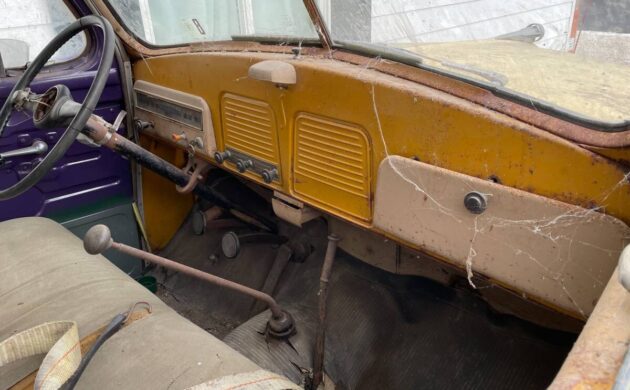I was so excited to find this 1951 Studebaker 2R10 barn find here on craigslist – not only because I love Studebaker trucks, but because the seller actually pulled the truck out of the barn for its photo session – kudos! This handsome project truck is located in Avon, Illinois and the seller is asking $2500 to give her over to a new owner. Robert Bourke – hired by Virgil Exner in 1940 to work for Studebaker’s design department alongside Raymond Loewy – penned the lines of the 2R truck series. The modeling was finished in 1945, but Studebaker was focused on producing passenger cars to meet post-war demand. The new truck was finally launched for model year 1949 and it represented a major departure from the bulbous fenders and running boards of the M-series. The bed incorporated double-wall construction so that if a load shifted, it would not damage the exterior sheet metal. A generous greenhouse helped distinguish the cab. While the M-series utilized several passenger car elements, the 2R shared very little with Studebaker’s cars. Gunter Kramer pitched us this excellent tip – thanks!
The 2R series ran from half-ton (2R5) through two-ton (2R17). This rig is a three-quarter ton, with a beefier frame and suspension versus its lighter sibling. Don’t expect a modern ride, though – these old trucks drive like buckboards. Buyers in 1951 settled for a 170 CID Econ-O-Miser flathead inline six-cylinder, with an output of about 85 hp – up 5 hp from the first ‘Misers thanks to an improved compression ratio. Yes, there’s enough torque to pull a stump. The standard gearbox was a three-speed column-shift manual but a four-speed floor-shift was available as an option or standard on the larger trucks. The seller notes that he hasn’t tried to start this motor yet.
The interior needs help, as it’s currently showcasing a few different colors. The flesh-tone glovebox and instrument panel are correct. Vent windows, two wiper blades, an adjustable bench seat, and Studebaker’s Air Climatizer system put the 2R head and shoulders above many of its competitors. Rubber floor mats were factory-supplied. One-piece windshields didn’t come along until 1954 when the truck became the 3R.
The bed is 8′ (respectable!); like many others of its ilk, a rear bumper was not even an option. You were lucky Studebaker provided two tail lights! Plenty of bodywork awaits the buyer, including a measure of rust. But the sky’s the limit for this reasonably-priced classic. Here’s a nice original example that sold for $18k about a year ago; or you can opt for the resto-mod route, shown here transforming a 2R5.






Boy, those are some beat up fenders.
What on earth happened to this truck? Those dents go well beyond “patina.”
Climatizer. Does this mean it has a heater?
Yes
And does the right rear wheel look a tad “toed in”?
The left rear does.
This will take a while to straighten out. That’s just a statement of fact, not some kind of attack.
As much as you’d be justified in making the analogy, it was simply my dyslexia that came up with right v left.
Ran when parked or ran when sideswiped a brick wall?
Ran when…..oh yeah, forgot to set the parking brake or from the looks of this unit, place brick behind rear wheel and truck rolled off cliff.
Apparently, unlike the rest here so far , some of us see a lot more potent for this old Stude. Does it need some work? Well yeah but it’s not some beat down rusted skeleton/ hole pocked shell of a pony car that the seller’s asking stupid money for-it’s an old truck at a VERY reasonable price that appears to complete. Does it look artificially beaten on yeah, it kinda does but it appears to be all there.
If it were closer it might already be here but we play the hand we’re dealt so no go on this round unfortunately..
When I was a kid, I tended to shy away from Studebaker trucks. I thought they were pudgy. But I have to admit that the 3/4 and 1-ton trucks had an appeal. I never saw either one out west but there were a number of larger trucks that made it. This one wouldn’t be much of a powerhouse but that crashbox would help it pull away with some heavy loads. I’m sure it used a Warner T-9, same as Ford and International so you would hear one coming down the road.